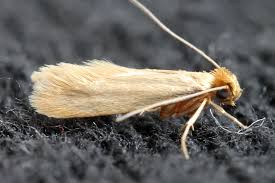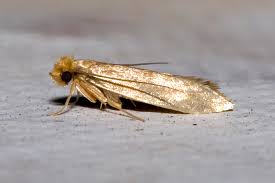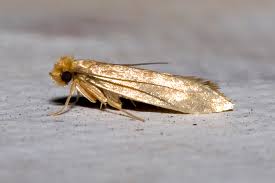Moths are insects that belong to the scientific order Lepidoptera. They are fascinating creatures with delicate wings covered in scales, often displaying a wide array of colors and patterns. Among the diverse moth species, one commonly encountered is the clothes moth, known for its unique habits and sometimes troublesome presence.
These nocturnal insects are attracted to light and are often seen fluttering around artificial sources during the night. While some moths are harmless and serve as essential pollinators for various plants, the clothes moth, scientifically known as Tineola bisselliella, can pose a challenge for those who wish to preserve their fabrics.
Clothes moths are small, measuring only a few millimeters in length, yet they can cause significant damage to textiles. The adult moths themselves do not feed on fabrics; rather, it is their larvae that voraciously consume materials such as wool, silk, and fur. This feeding behavior can lead to unsightly holes and damage in clothing, carpets, and other natural fiber-based items.
Understanding the life cycle of clothes moths is crucial for effective prevention. The process begins with the female moth laying tiny, nearly invisible eggs on susceptible materials. Once hatched, the larvae emerge and commence their destructive feeding phase. As they grow, these larvae spin silken threads, creating protective shelters where they can continue their development.
Preventing and managing clothes moth infestations involves several simple yet effective measures. Regular cleaning and vacuuming of closets, storage spaces, and carpets help eliminate larvae and eggs. Storing clothing in airtight containers or garment bags can also serve as a protective measure against these textile-damaging insects.
It’s important to note that moths play essential roles in ecosystems beyond their impact on fabrics. They contribute to pollination and are a crucial part of the food chain, serving as a food source for birds and other predators.
While some, like the clothes moth, may present challenges for human belongings, they are undeniably intricate and important contributors to the natural world. Appreciating their diversity and understanding their behavior allows us to coexist with these fascinating insects while preserving our cherished textiles.
Read Also: How Much Does It Cost to Adopt a Pet
Animals and Plants Affected by Moths (Lepidoptera)

Moths can have varying effects on animals and plants, both positive and negative. While some moths serve as essential pollinators for flowering plants, others may have detrimental impacts on certain crops or trees. Understanding these interactions sheds light on the intricate relationships within ecosystems.
1. Positive Impact on Plants:
Pollination: Many moths play a crucial role in pollination, transferring pollen between flowers as they feed on nectar. This helps in the reproduction of numerous plant species, contributing to the diversity and abundance of flowering plants.
2. Negative Impact on Plants:
Herbivory: Some moth caterpillars are herbivores that feed on the leaves, stems, or fruits of plants. While this may be part of the natural balance, certain species can become pests, causing damage to crops and impacting agricultural yields.
3. Impact on Animals:
Food Source: Moths, both in their caterpillar and adult stages, serve as a food source for various animals. Birds, bats, and other insect-eating creatures rely on moths as a nutritious part of their diet.
Parasitic Relationships: Certain moths have parasitic relationships with other insects. For example, there are moths whose larvae feed on the larvae of other insects, influencing the population dynamics within insect communities.
Predation: Moths, particularly their caterpillar stage, can fall prey to predators such as spiders, insects, and birds. This interaction is a fundamental aspect of the food web, contributing to the overall balance in ecosystems.
In essence, moths contribute to the intricate web of life through their interactions with plants and animals. While their impacts can be negative for some plants, they play crucial roles as pollinators and as a food source for various creatures. Recognizing and appreciating the complexity of these relationships is essential for maintaining the health and diversity of ecosystems.
Damages Caused by Moths

Moths, particularly certain species and their larvae, can cause various damages, primarily in the context of textiles, stored goods, and agricultural crops. Understanding these damages is crucial for implementing preventive measures and managing potential infestations.
1. Textile Damage:
Holes in Clothing: Clothes moths, like the common clothes moth (Tineola bisselliella), can be detrimental to fabrics. The larvae feed on natural fibers such as wool, silk, and fur, causing visible holes and damage to clothing items.
Carpet Damage: Moth larvae can also target carpets made of natural fibers, leading to unsightly and often irreparable damage.
2. Stored Goods:
Food Contamination: Some moths, such as Indian meal moths (Plodia interpunctella), infest stored food products like grains, cereals, and nuts. Larvae can contaminate these goods, rendering them unfit for consumption.
Damage to Stored Items: Moth larvae may infest stored items like blankets, upholstery, or natural-fiber-based furniture, causing damage and reducing the lifespan of these possessions.
3. Agricultural Damages:
Crop Damage: Moth caterpillars can be agricultural pests, damaging crops by feeding on leaves, stems, and fruits. For example, the European corn borer (Ostrinia nubilalis) is known to cause damage to corn crops.
Impact on Ornamental Plants: Certain moths can negatively affect ornamental plants in gardens by feeding on leaves and flowers.
4. Ecological Impact:
Impact on Ecosystems: In some cases, the introduction of non-native moths to new environments can disrupt ecosystems. For example, the gypsy moth (Lymantria dispar) has been known to defoliate large areas of forests, affecting local biodiversity.
Understanding the potential damages caused by moths allows individuals to take proactive measures to protect their belongings, stored goods, and crops. Implementing proper storage and hygiene practices can help minimize the risk of moth infestations and mitigate their impact on various aspects of daily life.
Read Also: Burmese Cat Breed (Felis catus) Description and Complete Care Guide
Control and Preventive Measures

Controlling and preventing moth infestations involves a combination of proactive measures and targeted interventions. Here are some effective strategies to manage moths and minimize their impact:
1. Preventive Measures:
Proper Storage: Store clothing and textiles in airtight containers or garment bags to prevent moths from accessing and laying eggs on fabrics. Regularly clean and vacuum closets, storage areas, and carpets to remove moth eggs and larvae.
Temperature and Humidity Control: Maintain a cool and dry environment, as moths thrive in warm and humid conditions. Use dehumidifiers if necessary. Consider storing items in climate-controlled spaces to deter moth activity.
Regular Cleaning: Wash clothing and textiles before storing them for an extended period to eliminate any existing moth eggs or larvae.
Clean and dust stored items regularly to reduce the availability of food sources for moth larvae.
Natural Repellents: Use natural moth repellents such as cedarwood blocks, lavender sachets, or dried rosemary in closets and storage areas. Place mothballs or cedar balls among stored items to deter moths.
2. Control Measures:
Insecticides: Use moth-specific insecticides, either in spray or powder form, on affected areas. Follow the product instructions carefully. Consider professional pest control services for severe infestations.
Traps: Place pheromone traps in closets or storage spaces to capture adult moths and disrupt their breeding cycle.
Sticky traps can be effective in catching moth larvae in specific areas.
Biological Controls: Introduce natural predators of moths, such as parasitic wasps, in outdoor environments to help control moth populations. Bacillus thuringiensis (Bt), a biological insecticide, can be applied to control moth caterpillars in agricultural settings.
Inspect and Quarantine: Regularly inspect stored items for signs of moth infestations and take immediate action if any are found.
Quarantine newly acquired clothing or textiles before introducing them to storage areas.
Combining these preventive and control measures creates a comprehensive approach to managing moth-related issues. By staying vigilant and implementing these strategies, individuals can safeguard their belongings, stored goods, and crops from the potential damages caused by moths.
Frequently Asked Questions (FAQs) About Moths (Lepidoptera)
1. Q: What attracts moths to clothing and textiles?
A: Moths are attracted to natural fibers like wool, silk, and fur, which serve as a food source for their larvae. Additionally, moths are drawn to body oils, sweat, and food stains on clothing.
2. Q: How do I know if I have a clothes moth infestation?
A: Signs include small holes in clothing, especially in hidden areas, and the presence of silken cocoons or larvae. Adult moths flying around or resting in dark areas may also indicate an infestation.
3. Q: Do moths only damage clothing?
A: No, some moths, like Indian meal moths, infest stored food products, while others can damage carpets, upholstery, and natural-fiber-based furniture.
4. Q: Can moths damage synthetic fabrics?
A: Moths are primarily attracted to natural fibers, but synthetic fabrics can still be damaged indirectly if moths are present in the environment, as they may use synthetic materials for shelter.
5. Q: How can I prevent moth infestations in my home?
A: Store clothing in airtight containers, regularly clean and vacuum storage areas, control humidity, use natural repellents like cedar, and inspect items for signs of infestation.
6. Q: Are mothballs safe to use?
A: Mothballs can be effective but should be used with caution due to their chemical content. Use them in well-ventilated areas and keep them away from children and pets.
7. Q: Can moths be beneficial?
A: Yes, moths play a crucial role in ecosystems as pollinators and a food source for various animals. However, certain species can become pests in specific contexts.
8. Q: What should I do if I find moth damage in my clothes?
A: Isolate affected items, clean them thoroughly, and consider freezing or heat-treating them to eliminate any remaining larvae. Use preventive measures to avoid future infestations.
9. Q: Do moths carry diseases?
A: Moths themselves do not carry diseases that affect humans. The primary concern is the damage caused by their larvae to textiles and stored goods.
10. Q: Can professional pest control help with moth infestations?
A: Yes, professional pest control services can provide effective solutions for severe moth infestations, including targeted insecticide treatments and preventive measures.
Read Also: How to Study For a Test

